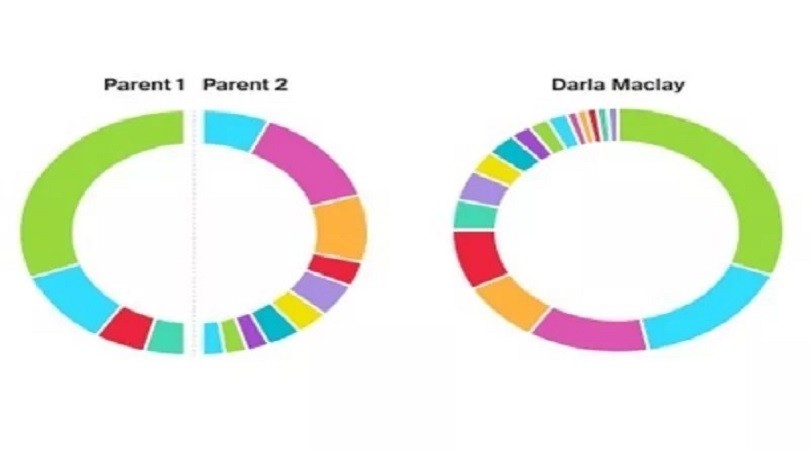Last Updated on January 6, 2025
Parent 1 on Ancestry DNA is the biological mother or father of the person being tested. The term is used to distinguish between the two parents, as opposed to adoptive or step-parents.
If you’re looking at your Ancestry DNA results, you may be wondering who is Parent 1. Here’s what you need to know about this key ancestor in your family tree.
Parent 1 is the first person in your direct maternal or paternal line.
This means they are your mother or father, respectively. If you have siblings, they will also share the same Parent 1.
Your Ancestry DNA results will show you how much DNA you share with each of your parents.
This can be helpful in understanding your genetic makeup and identifying potential health risks. It can also give you clues about your ancestry and help you connect with distant relatives.
If you’re curious about who Parent 1 is in your family, take a look at your Ancestry DNA results today.
You may be surprised at what you discover!

Credit: www.youtube.com
What Does Parent 1 Mean?
In the context of family law, “parent 1” refers to the biological or adoptive mother of a child. If a woman has given birth to a child, she is automatically considered the legal parent in most jurisdictions. In some cases, however, such as when a child is conceived through artificial insemination or when the parental rights of the biological father are terminated, the mother may be the sole legal parent.
How Do You Know If a Dna Match is Maternal Or Paternal?
When you receive a DNA match, you are given the option to view the match’s profile. On the profile, it will list if the match is maternal or paternal. If it does not say, then you can assume that the match is on your father’s side.
What Does 1 on Ancestrydna Mean?
If you’ve taken a DNA test with AncestryDNA, you may be curious about what your results mean. In this blog post, we’ll explain what the “1” in your AncestryDNA results indicates.
When you take a DNA test with AncestryDNA, our scientists analyze your DNA and compare it to our massive database of people from around the world.
Based on this comparison, we can tell you which populations you’re related to and estimate how much of your DNA comes from each population.
The “1” in your results means that 100% of the populations we tested could be placed into one category. This doesn’t necessarily mean that all of your ancestors were from that region—it just means that, based on the populations we tested, all of your ancestors could have come from that region.
There are a few reasons why this might happen:
Your ancestry is very well represented in our database. We have a large number of people from your region in our database, so we were able to confidently place all of your ancestors into one category.
You have recent ancestors from the region. If you have any recent ancestors (within the last few generations) who lived in the region, they would likely account for most or all of the DNA you inherited from that region.
We didn’t test enough populations to accurately place all of your ancestors.
Our database is constantly growing, and we are constantly adding new populations to our tests. As we add more populations, it’s possible that some of your ancestor(s) will be placed into different categories.
Is Ancestrydna Maternal Or Paternal?
When it comes to DNA, there are two different types: maternal and paternal. Maternal DNA is the DNA passed down from a person’s mother, while paternal DNA is the DNA passed down from a person’s father.
So, which one is AncestryDNA?
The answer is both! Depending on the test you take, you can get results for either your maternal or paternal line. For example, the mtDNA Test looks at your maternal line (your mother’s mother’s mother, etc.), while the Y-chromosome Test looks at your paternal line (your father’s father’s father, etc.).
If you want to know more about which test is right for you, AncestryDNA has a helpful guide that can point you in the right direction. No matter which test you take, though, you’re sure to get accurate and detailed results that will give you insights into your family history.
Ancestry’s New DNA SideView®: Separating Parents in Your DNA Ethnicity Estimates
Who is Parent 1 And Parent 2 on Ancestrydna
The answer to this question is not as simple as it may seem. While AncestryDNA does provide some information about who your parents are, they don’t give a definitive answer. This is because the DNA that is used to determine ancestry can come from many different people, not just your parents.
So while AncestryDNA can give you some clues about your parentage, they can’t say for sure who your parents are.
Conclusion
This blog post provides helpful information for people who are interested in learning more about how to use Ancestry DNA. It explains what Parent 1 is and how to determine who that is on your family tree. Ultimately, this post will be helpful for anyone who wants to learn more about their family history.








